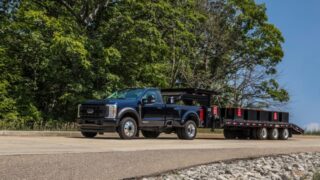2018 Ford F-150 Showdown: Diesel vs Gas
Head-to-head F-150 comparison reveals some pretty interesting results. And it should help make your next powertrain decision a little easier.
For decades, the Ford F-150, America’s perennial best-selling truck, has soldiered on with gas-powered engines. The most difficult choice consumers had to make essentially boiled down to trim levels. Then, the introduction of the Ecoboost V6 lineup left many of us in a conundrum, though those turbocharged engines have since taken over the sales charts. But for the first time in history, we now have a much different Ford F-150 engine choice – the 3.0-liter Power Stroke diesel.
That choice has already left many prospective buyers wondering whether they should make the switch to diesel power. And of course, the answer to that question isn’t so easy or obvious. Both diesel and gas engines have their own unique pros and cons. So comparisons between the two can prove quite helpful, like this one recently completed by Edmunds.
First up – fuel economy. Edmunds has had their 2.7-liter Ecoboost Ford F-150 for around 6 months, and they’ve accumulated 10,000 miles over that time frame. Interestingly, they’ve only managed to average 17 mpg, which is far below the truck’s EPA combined rating of 21 mpg. Their best tank came in at just 20.6. The diesel F-150, on the other hand, averaged 22.5 mpg on the trip from Denver to Los Angeles. Which is 0.5 above the truck’s combined rating of 22 mpgs.
The big kicker with any diesel upgrade, of course, is price. And in this case, opting for the 3.0-liter oil burner over the 2.7 will run you a significant $4,000. Plus, you can’t get the diesel in lower trim levels. So if you’re shopping for an XL or XLT, you’re out of luck. Edmunds’ Lariat stickered at $52k, one of the cheaper ways to get one.
But that extra cash doesn’t show up in performance, mind you. Edmunds managed a 0-60 run of 8.4 seconds and a quarter mile time of 16.2 in the diesel. The 2.7, on the other hand, did 0-60 in 6.3 seconds and the quarter in 14.7. But you don’t buy a truck to drag race, now do you?
The real advantage of diesels lie in their towing capability, and the Power Stroke F-150 really shines there. Its max capacity comes in at a little over 10,000 pounds versus the Ecoboost’s 8,000 pounds. But the real question is, how do these trucks compare in towing fuel economy? Edmunds has yet to test that, but it’s coming soon. And judging by these numbers, we’re guessing the Power Stroke will handily beat the Ecoboost in that regard!






